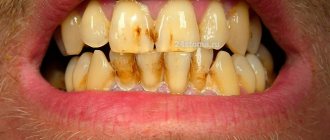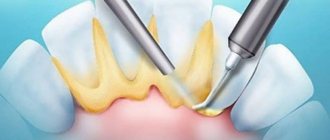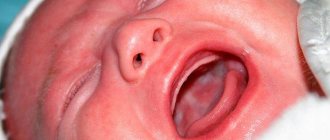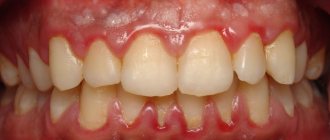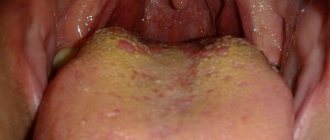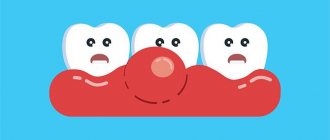When thrush appears in the mouth, the tongue becomes covered with a mucous membrane, where bacteria accumulate. This will become a provoking factor for the appearance of white plaque in the oral cavity. Candidiasis involves the covering of the upper layer of the oral mucosa by a fungus. It is necessary to differentiate pathological plaque from normal plaque. If unpleasant symptoms occur, you should consult your doctor.
Development mechanism
If there are no pathological processes and the internal organs function properly, then white plaque in the oral cavity will appear as a thin film, which can easily be removed after brushing the teeth.
The color of the tongue also changes after consuming various food products that contain a coloring enzyme. However, there are situations when white plaque can cover the oral cavity in a thick layer. Eliminating it is quite difficult, which can be a consequence of improper care, the use of certain medications, or viral diseases.
Doctor about oral candidiasis:
Causes
Often the appearance of white plaque in the mouth and the appearance of a persistent unpleasant odor indicate the formation of a fungal infection or diseases of the digestive tract.
Often the following diseases are the triggering factors:
- Acute and chronic gastritis.
- Peptic ulcer disease.
- Gallbladder diseases, hepatitis.
- Acute and chronic pancreatitis.
- Stomach cancer.
Important! In addition, the appearance of white plaque in the oral cavity indicates a deterioration in the immune system, metabolic failure, and fungus. Therefore, if there are initial symptoms of pathology, it is necessary to consult a specialist for a comprehensive diagnosis.
Kinds
Infection with oral fungus is accompanied by the creation of favorable conditions. Based on general health, oral candidiasis has a different course and location.
Often the pathology develops in infants and older people. If the body is weakened by constant ARVI or chronic diseases, then the immune system will not be able to counteract the pathogenic microflora and the disease will manifest itself.
By localization
The following types of diseases are distinguished by location:
- Oropharyngeal thrush . The cause is long-term use of antibiotics.
- Mycosis of the gums . A common occurrence associated with fungal infection. It also appears due to non-compliance with hygiene rules, smoking or the use of oral contraceptives.
- Damage to the corners of the mouth . During the development of pathology, cracks may bleed when opening the mouth. Mostly the disease is treated with ointments and creams.
Oropharyngeal thrush
Mycosis of the gums
Damage to the corners of the mouth
By shape
The disease can occur in various forms.
There is the following classification:
- Pseudomembranous acute candidiasis . Almost everyone is susceptible to the disease, but infants often suffer. Pathology can affect various parts of the oropharynx.
- Acute atrophic candidiasis . Formed due to inappropriate therapy. The tongue and corners of the lips become bright red. Plaque at this time is absent or appears only in hard-to-reach places.
- Chronic hyperplastic type . The disease affects the cheeks and tongue. The patient has white spots that differ in shape. The damaged areas become inflamed and redness forms near the white spots. If not treated promptly, the fungus leads to malignancy.
Pseudomembranous acute candidiasis
Acute atrophic candidiasis
Chronic hyperplastic type
Diagnostics of the oral cavity:
Causes of thrush in the mouth
Oral candidiasis is a common disease.
Very often a person does not even suspect that he is a carrier of Candida fungus. Its rapid reproduction occurs under the influence of several factors:
- long-term use of antibiotics, cytostatics or glucocorticosteroids;
- vitamin deficiency or hypovitaminosis, lack of iron in the body;
- impaired carbohydrate or fat metabolism;
- diabetes mellitus, problems with the thyroid gland, ovarian function;
- diseases of the gastrointestinal tract, genitourinary or reproductive systems in a chronic form;
- malignant neoplasms, AIDS;
- mechanical damage to the soft tissue of the gums;
- caries, impaired salivation, cyst, periodontitis;
- lack of regular cleaning of acrylic dentures;
- alcoholic beverages, tobacco products; bad ecology;
- frequent stress, overwork.
Reference! Oral thrush cannot appear on its own. It is a consequence of a violation or weakening of the body’s protective properties.
More information about the disease:
Treatment
To get rid of fungus in the mouth, you need to seek help from a doctor. Therapy for candidiasis is also carried out by influencing damaged mucous membranes with Decamine, Fluconazole and other antibacterial agents.
Ointments/gels for topical treatment
White plaque in the mouth can be effectively treated with the use of topical antibacterial ointments.
The following ointments are effective:
Nystatin
Levorinova
Advice! If you eliminate the disease by alternating these medications or combining them, then the unfavorable symptoms will disappear more quickly.
Pills
During the treatment of pathology, it is possible to use medications in tablet form. Levorin and Nystatin stand out. The tablets must be kept under the tongue until completely dissolved.
Levorin
Nystatin
Decamine will also be effective. It helps to quickly eliminate the lesion caused by oral candidiasis.
Caramel with Dekamin
Diflucan, Fluconazole and Nizoral are produced in capsules. They are used after consultation with a doctor.
Diflucan
Fluconazole
Nizoral
Rinse solutions
If the mouth is covered with a white coating, rinsing with disinfectant and alkaline solutions, which reduce the inflammatory process, helps eliminate unpleasant symptoms.
They are:
Boric acid
Sodium tetraborate
Baking soda
Iodinol
Rinsing should be regular after meals.
Traditional methods
Many patients prefer to eliminate white plaque in the mouth through traditional therapy.
The most common means:
- Calendula infusion.
- Juniper tincture.
- Infusion of oak bark.
- Rinse your mouth daily with viburnum, carrot or cranberry juice.
Treatment must be agreed with a doctor.
Features of treatment in children
In childhood, the disease can occur in an acute form and be accompanied by redness and swelling of the oral mucosa.
Pathology in a child occurs due to the following factors:
- Deterioration of the immune system.
- Infection during lactation.
- Transmission of bacteria during childbirth.
- Infection through household items.
Important! When the disease is not detected in a timely manner, a white coating forms in the child’s mouth, and in severe situations, ulcers appear.
Komarovsky on the treatment of oral thrush:
In adults
In adulthood, such a disease appears due to excessive consumption of foods that contain many carbohydrates.
White plaque can also appear due to various diets and poor drinking regimen. This can be affected by poor oral hygiene, smoking, and drinking alcohol. A balanced diet and plenty of drinking water, compliance with hygiene rules, and giving up bad habits prevent the occurrence of unpleasant symptoms.
Candidiasis can occur due to deterioration of the immune system, hormonal imbalance and due to complications after various diseases.
How to recognize - main symptoms
The main symptoms of oral thrush in adults include the appearance of plaques and milky plaque in the mouth. However, signs of the disease also include:
- Feeling of discomfort in the mouth.
If you listen to your body, you can detect the first symptoms of the disease in time. Thrush, for example, begins with itching, burning and painful sensations in areas where the mucous membrane is affected. The taste buds begin to lose sensitivity, and in the meantime, a metallic taste sometimes appears in the mouth.
- Lump in throat.
It appears not only during times of stress, anxiety or depression. This can happen if candida fungi begin to travel and reach the larynx. The swallowing process becomes difficult and interferes with normal food intake.
- Fever.
High temperature is a reaction to disturbances in the normal functioning of the body. In this case we are talking about the progression of the fungus.
- Bleeding.
The mucous membrane becomes irritated and instead of healthy tissue, bleeding abrasions form.
- Mycotic seizures.
Manifestation near the lips, namely in the corners, everything becomes red and covered with small cracks and transparent scales.
For a clear understanding of what kind of disease this is, here is a photo of thrush in the mouth in adults.
Some signs of the disease may not cause discomfort, however, this does not mean that thrush in the mouth will stop on its own. At the first symptoms, you should definitely consult a specialist and get tested.
Diet during treatment
When a patient is diagnosed with white plaque in the oral cavity, he is required to follow a dietary diet throughout the treatment.
It is advisable to exclude sweet, fatty, sour, smoked and spicy foods. The diet, in the presence of a disease, involves a ban:
- chocolate products and other products with high sugar content;
- food containing yeast;
- seasonings;
- smoked meats;
- fatty fish and meat;
- alcoholic drinks;
- highly carbonated water.
Following a healthy diet helps reduce unpleasant symptoms.
Possible complications
The disease can become chronic, go inside the body and provoke unpleasant consequences:
- respiratory diseases;
- dehydration;
- disorder in the functioning of the digestive tract, dysbacteriosis;
- the formation of sepsis due to infection in cracks and erosion.
To prevent the occurrence of adverse consequences, it is necessary to conduct a comprehensive diagnosis in a timely manner and implement appropriate treatment.
Quick treatment for oral thrush in children and adults:
Features of treatment in men and women
Therapy for fungal infections of the oral mucosa is the same for both men and women.
In both cases, it should be aimed at combating the pathogen, raising immunity and eliminating concomitant diseases. Particular attention during treatment should be given to pregnant or lactating women. Some medications can harm your baby's health. Therefore, the course of treatment should only be carried out by the attending physician. In this case, you should not self-medicate.
Analysis of a clinical case of oral thrush in a man:
Preventive measures
Prevention is aimed at improving the condition of the oral microflora.
It assumes:
- Compliance with oral hygiene rules.
- A balanced diet high in protein and low in foods containing glucose.
- Getting rid of bad habits (smoking and drinking alcoholic beverages).
- Timely diagnosis by the attending physician for preventive purposes.
- Avoid the use of various medications without prior consultation with a specialist.
- If the patient has dentures, regular treatment in a special solution will be a preventive measure.
Compliance with these instructions helps prevent the occurrence of unfavorable symptoms.
If white plaque appears in the mouth, you should seek help from a doctor. This will allow you to eliminate the disease as soon as possible and prevent the occurrence of complications.
Prevention
To prevent the onset of the disease, you must follow several expert tips :
- carry out daily oral hygiene;
- treat gastrointestinal diseases in a timely manner;
- timely treatment of caries or purulent pulpitis;
- take a course of vitamins in spring and autumn.
Thrush in the oral cavity in adults most often occurs against the background of reduced immunity or damage to tooth enamel. Therefore, it is very important to conduct timely examinations with specialists and undergo a course of treatment.




